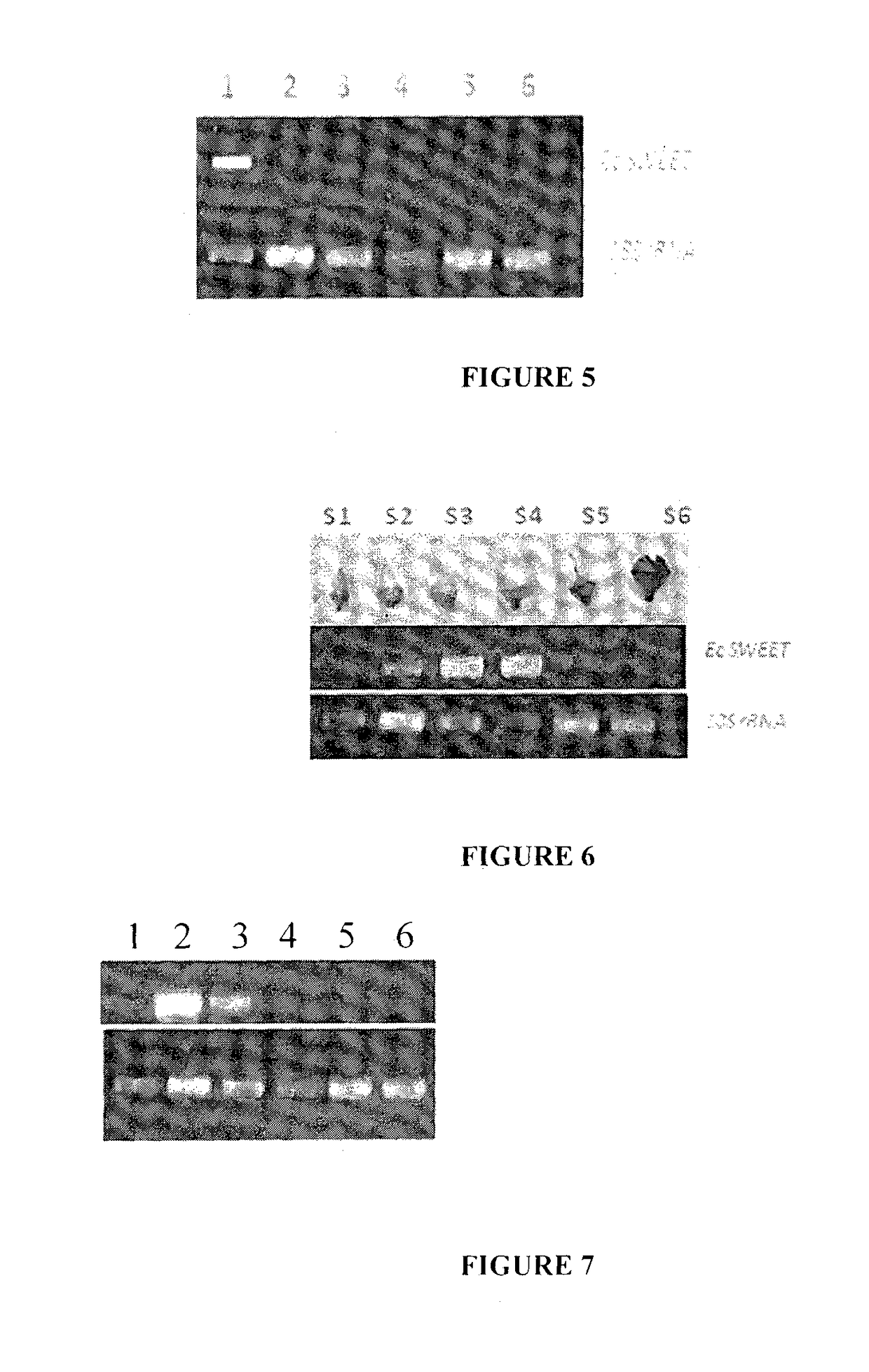Male reproductive tissue and stage specific promoters from Eucalyptus camaldulensis sweet gene family member
a stage specific promoter and male reproductive tissue technology, applied in the field of plant molecular biology and genetic engineering, can solve the problems of contaminated wild germplasm, inability to control the pollen production of trees, and the extent to which transgenes can escape cultivation and negatively impact the ecosystem,
- Summary
- Abstract
- Description
- Claims
- Application Information
AI Technical Summary
Benefits of technology
Problems solved by technology
Method used
Image
Examples
example 1
Isolation and Cloning of EcSWEETp
[0136]The forward primer namely IME 2230F having nucleotide sequence as set forth in SEQ ID NO: 2 and reverse primer namely 2231R having nucleotide sequence as set forth in SEQ ID NO: 3 were designed for the promoter region Eucgr.00360, which is homologous to Eucalyptus.camaldulensis (Ec) SWEET gene (EcSWEETp). The primers were used to amplify the promoter region from genomic DNA of Eucalyptus camaldulensis.
[0137]FIG. 1 shows the amplified polymerase chain reaction (PCR) product (lane designation ‘1’). Lane designation ‘M’ represents the molecular DNA ladder. The amplified PCR product thus obtained was cloned in a vector (pJET1.2) and transformed into DH5α E. coli cells as shown in FIG. 2 (lane designation ‘M’ represents the molecular DNA ladder). The recombinant vector is name as pJET:EcSWEETp. Further, the amplified PCR product obtained from the PCR reaction was subjected to sequencing reaction using vector specific primers. The sequencing reactio...
example 2
Analysis of EcSWEET Promoter Region by PLACE Software
[0139]The sequence of EcSWEET promoter was analysed by online PLACE (Plant Cis-acting Regulatory DNA Elements) to find signals and possible functions in the promoter region. (Table 1)
[0140]
TABLE 1List of major elements found in EcSWEETp by PLACE analysisFactor / SiteSignalNoNameSequenceFunction 12SSEEDPRO(+)Conserved in storage-TBANAPACAAACACprotein gene promoters and important for high activity of the napA promoter 2ABRELATER(+)required for etiolation-D1ACGTGinduced expression of erd1 (early responsiveto dehydration) in 3ABREOSRA(+)ABA responsive element B21ACGTSSSC(ABRE) of wheat and rice rab21 genes 4ACGTATER(+)required for etiolation-D1ACGTinduced expression of erd1 (early responsive to dehydration) in 5ARFAT(−)ARF (auxin response TGTCTCfactor) binding site found in the promoters of primary / early auxin response genes of A.thaliana. 6ARR1AT(+)ARR1-binding element NGATTfound in Arabidopsis; ARR1 is a responseregulator 7ASF1M...
example 3
Cloning and Preparation of Vectors for Minimal Promoter Analysis
[0141]Amplification of a nucleotide fragment having size of 976 bp, 518 bp or 247 bp was carried out using forward and reverse primers as set forth in SEQ ID NO: 2 and SEQ ID NO: 3, SEQ ID NO: 5 and SEQ ID NO: 3 and SEQ ID NO: 6 and SEQ ID NO: 3 respectively. The above mentioned three polynucleotide fragments were amplified from the vector pJET:EcSWEETp. The primers carrying engineered XbaI and HindIII recognition sequences were used for the amplication of the three nucleotide fragments. The reactions were carried out in a total volume of 204, with one microgram of plasmid DNA along with 1 unit each of XbaI and HindIII. The promoter region was amplified from pJET:EcSWEETp using forward and reverse primers. As shown in FIG. 3, the PCR product was cloned in to pBI121 vector using infusion cloning reagents as per the manufactures instructions (Takara). The PCR products were ligated in to pBI121 vector and transformed in to...
PUM
| Property | Measurement | Unit |
|---|---|---|
| pH | aaaaa | aaaaa |
| abiotic stress | aaaaa | aaaaa |
| resistance | aaaaa | aaaaa |
Abstract
Description
Claims
Application Information
 Login to View More
Login to View More - R&D
- Intellectual Property
- Life Sciences
- Materials
- Tech Scout
- Unparalleled Data Quality
- Higher Quality Content
- 60% Fewer Hallucinations
Browse by: Latest US Patents, China's latest patents, Technical Efficacy Thesaurus, Application Domain, Technology Topic, Popular Technical Reports.
© 2025 PatSnap. All rights reserved.Legal|Privacy policy|Modern Slavery Act Transparency Statement|Sitemap|About US| Contact US: help@patsnap.com



